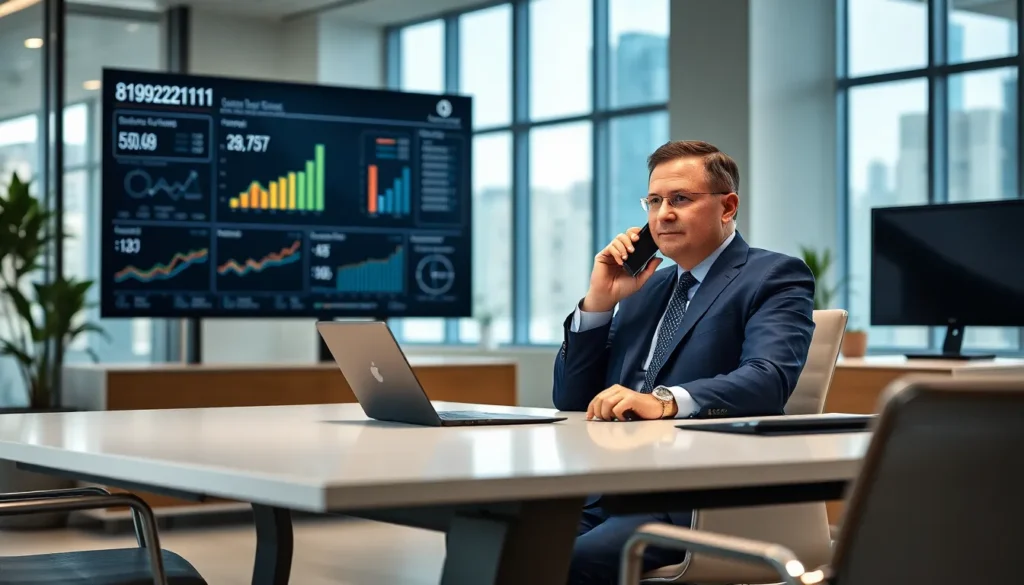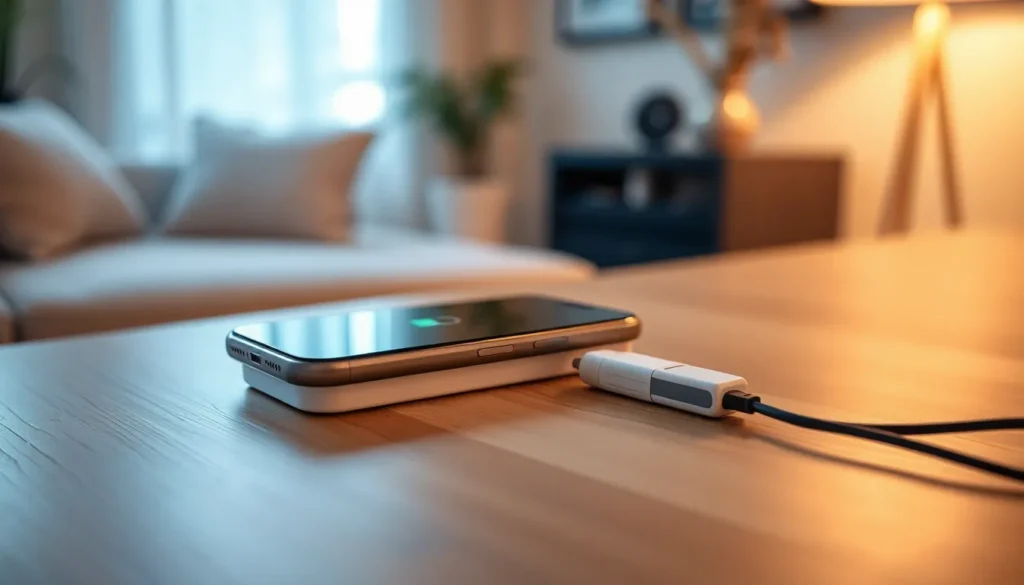Table of Contents
ToggleEver found yourself staring at a dead iPhone, feeling like you’ve just lost your best friend? You’re not alone. In a world where connectivity reigns supreme, a lifeless phone can feel like a mini crisis. The good news? Charging it back to life doesn’t take as long as waiting for your favorite show to buffer.
Overview of iPhone Charging
Charging times for an iPhone vary based on several factors. Device model significantly impacts the charging speed; newer models support faster charging technologies. For example, the iPhone 12 and later can charge up to 50% in about 30 minutes using a 20W adapter. Users should consider their charger type as well; using an Apple-certified charger will ensure optimal performance.
Battery health plays a crucial role too. A well-maintained battery charges faster than one that’s worn out. Regularly checking battery health in settings can provide insight into overall performance. Users often notice slower charging over time due to wear and tear on the battery.
Charging methods can also influence time. Fast charging options, like USB-C and wireless charging, offer different experiences. Wireless charging typically takes longer, around 60%-90 minutes to reach up to 100% depending on the charger. Direct USB-C connections generally yield quicker results.
The environment affects charging as well. Cooler temperatures can lead to optimal charging conditions, while extreme heat can slow down the process or even harm the battery. Avoiding direct sunlight and hot surfaces during charging maximizes effectiveness.
Lastly, activity during charging can slow down the process. Using the phone for heavy tasks, such as gaming or streaming, drains the battery faster than it charges. For best results, limiting phone usage while charging ensures quicker rejuvenation.
Factors Affecting Charging Time

Charging time for an iPhone varies based on several factors. Understanding these factors can help users optimize their charging experience.
Battery Capacity
Battery capacity significantly impacts charging time. Larger batteries take longer to charge fully. For example, the iPhone 14 has a battery capacity of 3,279 mAh, which translates to longer charging times compared to smaller models like the iPhone SE with a 1,821 mAh battery. Users may notice that charging from 0% to 50% takes a shorter time than reaching 100%.
Charger Wattage
Charger wattage plays a critical role in how quickly an iPhone charges. Higher wattage chargers, such as 20W, can provide faster charging compared to the standard 5W chargers. Using an Apple-certified charger ensures optimal charging speeds. For instance, an iPhone can charge up to 50% in just 30 minutes when connected to a 20W charger.
Background Processes
Background processes can slow down charging times. Running apps or updates during charging consumes battery power, prolonging the time to reach a full charge. Users might want to minimize background activity by closing unnecessary apps. Turning on Airplane Mode while charging also proves beneficial, leading to quicker charging results.
Charging Methods
Charging methods significantly impact the time it takes an iPhone to recharge from dead. Understanding the differences helps users make informed choices.
Wall Charger
Wall chargers provide the quickest charging option for iPhones. A typical 20W charger can charge an iPhone to about 50% in roughly 30 minutes. Models such as the iPhone 12 and later benefit from fast charging capability, making them ideal for those in a hurry. Using an Apple-certified charger ensures compatibility and optimal performance. Users can expect varies from model to model, with larger batteries, like the iPhone 14, requiring more time to fully charge compared to smaller ones, like the iPhone SE.
Wireless Charger
Wireless chargers offer convenience without tangled cords. However, charging speeds often lag behind wall chargers. Standard wireless chargers typically provide around 7.5W, causing longer charging times compared to wired options. Fast wireless chargers can hit up to 15W, but not all iPhones support this feature. Environmental conditions, such as heat, can affect charging efficiency, often slowing down the process. When using a wireless charger, ensuring proper alignment between the iPhone and charger is crucial for achieving optimal charging speeds.
Average Charging Times
Charging an iPhone from dead varies by several factors, including model and charging method. Users can expect differing times based on these elements.
From 0% to 50%
Charging an iPhone to 50% takes roughly 30 minutes with a 20W wall charger. This charger significantly shortens wait times compared to standard 5W chargers. Models like the iPhone 12 and later excel at achieving this faster rate due to their optimizations. Background activities can slow the process, so enabling Airplane Mode helps cut down on distractions. Users observing optimal conditions reap the benefits of fast charging, achieving near half capacity in a fraction of the time.
From 0% to 100%
Completing a full charge typically takes about 1.5 to 2 hours with a 20W charger. For models like the iPhone 14, the larger battery capacity plays a role in longer full charging times compared to smaller models. Wireless charging options, while convenient, usually extend the duration to nearly 3 hours for full capacity. Environmental factors such as temperature also influence overall charging efficiency. Maintaining an optimal charging environment helps users reach 100% in the shortest time possible.
Tips for Faster Charging
Utilize a higher wattage charger for quicker charging times. A 20W charger can charge an iPhone to about 50% in roughly 30 minutes. Opt for a wall charger instead of a USB port for improved efficiency. Wall chargers deliver power directly, maximizing output.
Minimize background activity to enhance charging speed. Closing apps and enabling Airplane Mode limits usage from live processes. Reducing active notifications can also prevent disruptions.
Consider the charging environment. Keeping the iPhone in a cool, dry place optimizes charging efficiency. Excessive heat can impact battery performance and slow down charging.
Disconnect accessories while charging. Removing cases or external devices reduces heat buildup, allowing for faster charging. This small action can significantly influence overall charging times.
Choose certified cables and adapters for optimal safety and performance. Using Apple-certified accessories ensures compatibility with the iPhone’s charging system. Avoid third-party products that might not meet safety standards.
Charging during idle times encourages faster results. When the iPhone is not actively in use, it can focus solely on charging, speeding up the process. Scheduling charging sessions around low-usage periods maximizes efficiency.
Using a power bank can provide quick access to charging on the go. High-capacity power banks replicate wall charging speeds in portable options. Ensure that the power bank has sufficient output for effective charging.
Maintaining battery health is crucial for optimal performance. Regularly updating the iPhone’s software can fix bugs that may slow down charging. Following recommended practices helps extend the lifespan of the battery while ensuring faster charging rates.
Charging an iPhone from dead doesn’t have to be a cumbersome task. By understanding the factors that influence charging times, users can optimize their experience. Whether it’s choosing the right charger or minimizing background activity, small adjustments can lead to quicker results.
Maintaining battery health and selecting appropriate charging methods are essential for efficiency. With the right approach, reviving a dead iPhone can be a swift process, allowing users to reconnect with their digital lives in no time.







